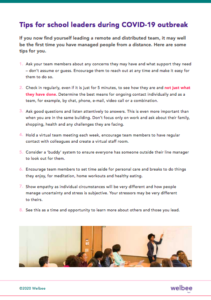School leaders and staff have been thrown into the next century overnight, with a forced work-from-home policy and little or no face-to-face interaction. It will feel strange not to be in the usual workplace and particularly for those of your staff who spend most of their time in the classroom. School leadership in crisis takes some patience and requires you to build new habits.
Below you can read and download 8 simple tips on leading remotely and supporting staff wellbeing. In our article on leading in a crisis we cover more extensive measures you might want to take.
How can you help your school staff in a crisis?
- Ask your team members about any concerns they may have and what support they need – don’t assume or guess. Encourage them to reach out at any time and make it easy for them to do so.
- Check in regularly, even if it is just for 5 minutes, to see how they are and not just what they have done. Determine the best means for ongoing contact individually and as a team, for example by chat, phone, e-mail, video call or a combination.
- Ask good questions and listen attentively to answers. This is even more important than when you are in the same building. Don’t focus only on work and ask about their family, shopping, health and any challenges they are facing.
- Hold a virtual team meeting each week, encourage team members to have regular contact with colleagues and create a virtual staff room.
- Consider a ‘buddy’ system to ensure everyone has someone outside their line manager to look out for them.
- Encourage team members to set time aside for personal care and breaks to do things they enjoy, for meditation, home workouts and healthy eating.
- Show empathy as individual circumstances will be very different and how people manage uncertainty and stress is subjective. Your stressors may be very different to theirs.
- See this as a time and opportunity to learn more about others and those you lead.
Remember: one size does not fit all. Every staff member will have to find their own way to overcome initial struggles, such as managing isolation and feelings of insecurity, learning how to work remotely and using new technology. Following these tips on leadership in crisis will support them in doing this.
Click here if you want to download these tips as a PDF document.

